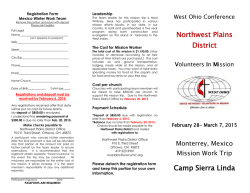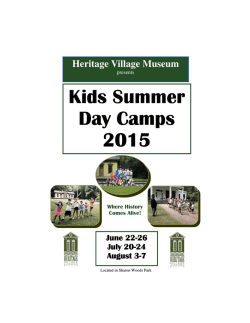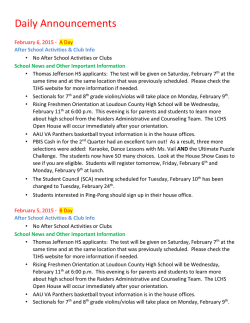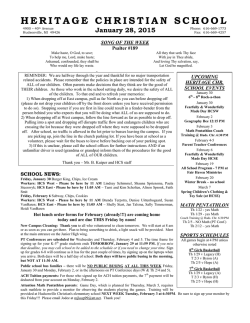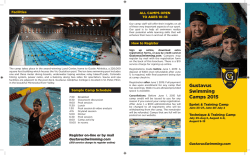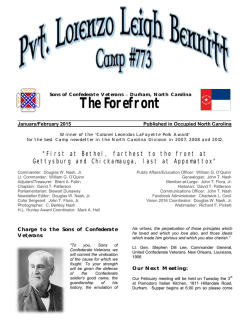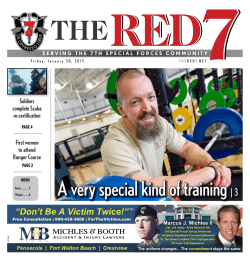
Extra! “Our Camp Journal”
Renew your membership today! Volume 21, Issue 6 “We are but few in number but formidable.” -Pvt. James Shelton, 7th Md. Co. B February 2015 The Officer and Non-Commissioned Officers for 2015, from left, 2nd Sgt. Steve Blumberg, 1st Sgt. Steve Giovannini, Capt. Jeff Bush, Cpl. Dan Paterson, Jr., Cpl. Scott Blumberg, Cpl. Mark Blumberg and newly elected Cpl. Erik Schwetje. Inside this issue: Upcoming Campaigns 2 On the Bookshelf 6 Ladies’ Knapsack 7 Greetings Members and friends of the 7th. I want to thank all those who were able to attend our annual business meeting for their effort and contribution, it was great to see you again. For those of you who were not able to attend, you were missed, and you missed some good discussion and comradery. Of particular importance was the presentation of the first Steve Bush Me- morial Award, given to the person who best demonstrates the level of imagination and spirit put forth by our dear departed friend and observed by so many at events throughout the years. I won’t try to describe the presentation, I couldn’t do it justice. You’ll have to ask about it when you get to camp. Congratulations, Private Pat Ellis, I look forward to following Steve’s example alongside you this coming season and beyond. Sgt Stephen Blumberg President Congratulations to the NCO’s and organization officers elected or re-elected for this (Continued on page 8) OUR CAMP JOURNAL PAGE 2 FEBRUARY February 21: Company Drill; Marietta Mansion, Time TBA. (Snow date 2/28) (COMPANY) MARCH March 13: Salisbury Living History, contact Capt. Jeff Bush (Individual) March 21-22: 150th Bentonville, NC (COMPANY) APRIL April 10-12: Long Road Home, 150th Appomattox, (COMPANY) (AOP/FVB Event) April 18-19: Marching Through Time, Marietta Mansion, Glenn Dale. (COMPANY) MAY May 16-17: 151st Battle of New Market, New Market VA. (COMPANY) (AOP/FVB Event) VO LUM E 20 , ISS UE 11 August 21-23: 25th Annual 93rd PA event Old Union Canal Tunnel (First Regiment Event) (Individual) JUNE June 13-14: Old Bedford Village, Birney’s Event, Old Bedford, PA (COMPANY) JULY July 3-5th: 152nd Gettysburg, Pumping Station Rd., Gettysburg, PA (COMPANY) (AOP/FVB Event) July 17-19: Funkstown, MD, (COMPANY) AUGUST August 8-9: Renfrew Museum, Waynesboro (139th PA) (First Regiment Event) (COMPANY) May 2-3: Carroll County Farm Museum, Westminster, MD. SEPTEMBER September 12-13th: Fall Muster at St. Thomas, Chambersburg, PA Cavalry Sponsored, 7th Maryland Soiree, Date / location TBA (COMPANY) OCTOBER October 3-4: Maryland Brigade Event, Baltimore, MD (Individual) October 17-18: 151st Cedar Creek, Middletown, VA (COMPANY) (AOP/FVB Event) NOVEMBER November 21-22: FVB Annual Meeting, Remembrance Day (COMPANY) (AOP/FVB Event) (Individual) It’s been a very busy January with many meetings, conference calls and emails. However, the season is shaping up to be another grand time. With the winddown of the sesquicentennial events we are positioning the Brigade and looking towards the future. Our aim is to continue our steady course. As folks may leave the hobby, we are looking to re-double our efforts to attract younger, history-oriented members as they are destined to be the future of reenacting. We’re looking to add as many “eventswithin-events” as we can during the season, such as drill competitions, dances and sports competitions. Any Gen. Jay Henson FVB Commander ideas you may have would be welcome. Thanks to all who attended the 7th MD annual meeting. It looks as though we’ll be having a grand time on the field and in camp. VO LU ME 20 , ISS UE 11 I am very excited about this year. Yes we are nearing the end of the 150th Anniversary events, but that’s not the end of the fun. There has been little change to our leadership on and off the field. This gives us some continuity that should get us right back to where we left off at Cedar Creek last year! I am very pleased to have all of the NCO’s back with the exception of one, Phillip Giovannini will be missed. I would like to welcome Eric Schwetjee to the NCO corps, he is a great addition! As far as our schedule goes it is not as intense as the last couple of years. This can work in our favor. It should give us the opportunity to add to our overall impression in camp especially. I encourage everyone to bring forward ideas for camp scenarios as well as helping to add Civil War winters were particularly trying and monotonous for the armies. Impassable, muddy roads and harsh weather precluded active operations. Disease ran rampant, killing more men than battles. But with all of its hardships winter OUR CAMP JOURNAL to anything that transpires from the Brigade. As we learned from the reports of the FVB Capt. Jeff Bush meetings we have Company Commander all been encouraged to continue to portray camp life activities. Let’s see some ideas and start “scheming”! Congratulations to Young William Hart for receiving the Farby Barby Award, he has waited a long time for his antics to be recognized with top honors! He joins a short list of other 7th also allowed soldiers an opportunity to bond, have a bit of fun, and enjoy their more permanent camps. Through these bleak months all soldiers, Union and Confederate, had to keep warm and busy in order to survive. “Dec. 20/64 – The weather is cold, but we keep up our drills believing it is to be better for the men.” – Elisha Hunt Rhodes, 2nd Rhode Island Volunteers PAGE 3 Marylanders who have gained possession of this coveted award. For those of you who chose to stay away from the annual meeting missed the presentation of a new award. I am very proud to have Patrick Ellis receive the Steve Bush Legacy Award. There is no one I can think of that deserves to be the first recipient more than Patrick. He has always found ways to enhance our experiences and my brother was somewhere nearby to help. You can bet I will be taking notes all year long to ensure that these two awards are given to deserving people. Let the antics begin and good luck! I look forward to the new season and hope to see everyone at our Company Drill on February 21st. We hope to give you something a little more advanced in drill this year. Yes we will knock some rust off but we hope to keep that brief! The FVB wants to try some new maneuvers and it all starts at the company level, so don’t be one of those that end up in the awkward squad and be sure to join us on the 21st and I will see you at the fire! While on the move in warmer weather, soldiers often slept in, easilyerected canvas tents or they simply slept without cover, under the stars. In the winter, large camps were established with more substantial shelter. Winter huts were built by the armies out of the surrounding materials including: trees, mud, leaves, and soldiers’ canvases. These huts usually included a chimney, which kept the small space warm, but some were more effectively built than others. The camps were set-up much like small villages complete with crisscrossing lanes called "company streets", churches, and sutlers’ shops. While this may seem cozy, these temporary villages lacked the appropriate systems to provide clean water and clear away waste; additionally, food was scarce. Disease (Continued on page 6) PAGE 4 OUR CAMP JOURNAL VO LUME 20, ISS UE 11 for a total of 1,539. The South lost around 1,160 men including two generals. Division commander Major General John Pegram was killed and brigade Commander Brigadier General Moxley Sorrel, a former staff officer of General James Longstreet, was shot through the lung and disabled for the rest of the war. Cpl. Dan Paterson Jr. Vice President The 7th Maryland February 1865: The Battle of Dabney’s Mill On February 5, 1865, at the Battle of Dabney's Mill (also known as Hatcher's Run), Union and Confederate forces around Petersburg, Virginia, began a three-day battle that produces 3,000 casualties but ends with no significant advantage for either side. This was another attempt by Union General Ulysses S. Grant to break the siege of Petersburg and Richmond, Virginia by gaining the Boydton Plank Road (modern route 1). The lines around Petersburg eventually stretched 25 miles to Richmond, and the stalemate continued to the breakthrough of April 2nd, 1865. Grant sent cavalry under General David Gregg to capture a road that carried supplies from Hicksford, Virginia, into Petersburg. On February 5, Gregg moved and captured a few wagons along his objective, the Boydton Plank Road. He found little else, so he pulled back toward the rest of the Union Army. Federal infantry under General Gouverneur K. Warren (the Union 5th Corps, of which our 7th Maryland was a part) also moved forward and probed the area at the end of the Confederate's Petersburg line. The Rebels responded by moving troops into the area. Skirmishes erupted that evening and the fighting continued for two more days as each side maneuvered for an advantage. Hospital Attendants Collect The Wounded Hdabney’s Mill. Sketch by William Waud . The fighting surged back and forth around Dabney's Mill, but the Federals were never able to penetrate the Confederate lines. The battle did extend the Petersburg line a few miles to further stretch Lee's thin lines, but that was the extent of the results. Dabney’s Mill is located six miles southwest of Petersburg, Virginia along Vaughn Road around Hatcher's Run. A letter from James Shelton of company B to his wife gives us an eyewitness description of the action: “ The fight we were in on the 6th inst. was the severest in musketry of the campaign. Although our loss was small as usual we were compelled to bear the brunt & then get no credit. But there is a day coming when the old Md. Line will stand out in bold relief in the rebellion as it did in ‘76 and 1812-13-&14. We are but few in number but formidable.” At this action 7th Maryland under the command of Lieutenant-Colonel David T. Bennett and was in the 2nd Brigade (Colonel R.N. Bowerman) of the 2nd Division (Bvt. Major General R.B. Ayres) of the 5th Corps. (Maj. Gen. G.K. Warren) The Federals losses here were 171 killed, 1,181 wounded and 187 captured, Grant was unable to permanently cut the Boydton Plank Road but found that the Confederates were barely using it due to the threat of being raided. The fighting allowed the Union defenses to be extended three miles and forced the Confederates to do the same, even though they were dangerously near the breaking point. The only Federal units to reach the Boydton Plank Road belonged to the cavalry, but in view of the Confederate response and the discovery that General Lee was not utilizing this road to supply his army, they were recalled. Consequently, no effort was made to hold the Boydton Plank Road, but the Federals did occupy and fortify the newly extended line to Hatcher's Run at a point 3 miles below Burgess' Mill. Thus, again the Union lines had been pushed to the west, and, as before, Lee was forced to lengthen his defenses. The Petersburg-Richmond front, with its recent extension, now stretched over 37 miles, and the army holding it had dwindled through casualties and desertion to approximately 46,000 on March 1, 1865. The relentless extension around Petersburg, which continued day by day with the addition of a few more feet or yards of picket line and rifle-pits, continued with The Battle at Hatcher’s Run which was the last significant thrust by the Federal Army to encircle the city of Petersburg until the breakthrough of 2 April 1865. Significant Events of February 1865 February 1: Illinois became the first state to ratify the 13th Amendment. February 3: On the River Queen five men, US President Abraham Lincoln, US Secretary of State William Seward, CS Vice-president Alexander Stephens, along with John Campbell and R.M.T. Hunter discuss peace terms at the Hampton Roads Conference near Fort (Continued on page 8) VOLUME 20, ISSUE 11 OUR CAMP JOURNAL PA GE 5 [Editor’s note: This book contains a wealth of informative photographs enabling the reader to research uniforms, arms and event postures during the American Civil War.] Photography was invented just twenty years before the American Civil War. In many ways the war—its documentation, its soldiers, its battlefields—was the arena of the camera's debut in America. "The medium of photography was very young at the time the war began but it quickly emerged into the medium it is today," says Jeff Rosenheim, curator of the exhibition Photography and the American Civil War , and author of its accompanying catalogue [book]. "I think that we are where we are in photographic history, in cultural history, because of what happened during the Civil War . . . it's the crucible of American history. The war changed the idea of what individual freedom meant; we abolished slavery, we unified our country, we did all those things, but with some really interesting new tools, one of which was photography." To use the bayonet as a frying pan handle for a canteen half, fix a "U" shaped wire to the side where the canteen spout would have nestled in to. The wire slips over the bayonet locking ring and the socket face against the pan. It holds pretty sturdy. As the catalogue discusses, photography served many purposes during the war. It was used to promote abolition; as propaganda for both the northern and southern causes; as an important tool in the creation of Lincoln's public persona and career; as well as for reconnaissance and tactical observation. The Civil War also marks the beginning of photojournalism as we understand it today. Photographers in the field who worked for name-brand studios like those of Mathew B. Brady and Alexander Gardner can be understood as the first embedded journalists. In his illuminating text, Rosenheim posits that Brady and the many others who made the photography of war their business came to understand the social responsibility that was part of their art, the responsibility the camera gave them. "The Civil War created an incredible (Continued on page 6) PAGE 6 OUR CAMP JOURNAL VOLUME 20 ISSUE 11 (Continued from page 3) and death abounded and spread easily. (Continued from page 5) demand for photography. It was used by the Union and Confederate armies and of course by regular Americans who wanted photographs of their family time of great democratic change," says Rosenheim. By 1863, thousands of people could afford to buy and commission photographs. "To see a photograph of yourself gave people a sense of their However bad the weather, boredom was an ever-present problem. Commanders and soldiers alike tried to establish regular activity and work to break the monotony. Drilling, camp up-keep, religious services, letter writing, card games, storytelling, and even the occasional snow ball fight were all part of camp life. Despite the best efforts of their officers, or lack thereof, many soldiers strayed to less desirable activities. As the war progressed winter encampments displayed the resources available to each army. The Confederacy began to run low on supplies and food, and their camps suffered while Union might, supplies, and transportation facilitated more comfortable winter for its soldiers. When the spring arrived, soldiers gathered their belongings including their canvasses and marched away. However, remnants of the camp remained and in some cases, soldiers saw their old camp again. Confederate Corporal (?) with British Rifle Musket and Bowie memKnife, Likely from Georgia, 1861–62 (?), Sixth-plate ambrotype individuality." bers heading with applied color. David Wynn Vaughn Collection; Unknown artist, Private James House, Sixteenth Georgia Cavalry BattalIn his planinto ion, Army of Tennessee, 1861–62 (?). Sixth-plate ruby glass ning for the danger, ambrotype. David Wynn Vaughn Collection exhibition and and of book, Rosenthe heim scoured records from photography battle scenes themselves," Rosenheim historians and from Civil War specialexplains. "It's hard to imagine the paists, the military, newspapers, the Lithos of people buying photographs of brary of Congress, and websites develbattlefields and slaughter and meticuoped by individuals simply uploading lously inserting the prints into photogfamily portraits. "All of this incredible raphy portrait albums. But this was information is coming together on the happening on a mass scale. I think Web—enlistment records, photographs there may have been a superstitious with rare period inscriptions on the element to it. Families may have felt verso, scans of newspaper engravings— that if they could put pictures of their and now in many cases we are able to brothers, sons, husbands into an alput together who made the photobum—to contain their likenesses in graphs, where and when they were some way—that they could stop their made, and who or what regiment is death." As the catalogue discusses, most depicted. Every day something new is stationers and portrait galleries—and added to the digital universe, be it a there were many—were in business to new name in a government database, or accommodate soldiers' needs. People the discovery of a single photograph were dying so quickly, families wanted from someone's attic." something to hold on to. This tremendous demand galvanized a rapid advancement in camera technology in the Civil War years, allowing for easier and cheaper photography. "This was a VO LUME 20 , ISS UE 11 The 7th Maryland held their company meeting in January; and now the civilians of the 7th Maryland plan to meet in February. We have much to discuss and plan for to get ready for this coming year, and some of the preliminary discussions have started in preparation for the meeting. One of the first things on the agenda will be the logo for our recently formed Parlor Soldiers (and no, the name is not any reference to ladies of the night). We’ve been using a logo on our food labels, and would like to branch out and advertise ourselves a little more. We’ll be playing around with and discussing possibilities for the logo and name design, as well as our ‘other’ name of Historians of Dubious Sanity. We would like to be able to incorporate all of this information in order to advertise ourselves and get our mission further out into the community. This discussion will lead into attempting to copyright our final product, so that we can utilize our Facebook pages and other websites to share even more. We will also start planning for Marching thru Time; though this is not a company event this year, it is still a highly suggested individual event. Part of the civilians attended MTT last year, in conjunction with the South Mountain event, as our first appearance as a sutler, where we were able to raise more OUR CAMP JOURNAL money towards our final goal. We’ve learned the trick to MTT – low cost baked goods that involve chocolate. What we like to do is something of a baked goods walk through the centuries; this allows us to bake items from the 1700s to 1950s, matching the theme of MTT. This year we’re looking forward to doing this again, and possibly even expanding into other ideas. More information on those possibilities will come later. Funkstown is also discussed during this meeting. Though this event has become easy for us to prepare for, we still like to cover all of our bases and make sure we won’t have any surprises for the event. This is an event where we can branch out from baked goods and sell handmade wares; the sutlers at the event enjoy buying our wares from us, and we will not argue with that. Mail call is another agenda item for the meeting. Several years ago we were able to have a mail call, and we’ve been trying since then with little success (for multiple reasons). So we’re going to give it another try this year, and hope that it’ll turn out better. At our meetings, we also take a look at the rest of the 7th MD event calendar and plan out activities for each event. PAGE 7 We usually have the tendency of aiming high and planning several different things Miss Sarah Harris for each event, in Civilian the hopes that at Coordinator least a few of those plans will actually happen. One of the activities we will be discussing is holding a sewing circle to work on our Parlor Soldiers banner. And, we would love to plan some activities that would parallel the activities being held for soldiers during events. If you would like to join our meeting, please do so! We will be meeting on February 8; you can get in touch with me for further information if you’re interested. On a more personal note, I will be having surgery sometime in February to repair a torn meniscus and ACL in my right knee (yeah, I know, I’m really good at tearing stuff). I’m remaining optimistic though, because from what I’m being told, it will be a shorter recovery time than a torn Achilles tendon. If all goes well, I will be out of any major braces by the first big event, and can come up with a good story to explain any limp I might have out on the field. (And, of course, I’ll be good to go for the wedding, I already checked on that). I’m really looking forward to this year, and I hope everyone else is too. There are some exciting events planned, but we have the opportunity to make them even better. (Continued from page 1) season, and thank you for your commitment and dedication. And thank you for the votes to re-elect me as President of the organization for another term, I appreciate your confidence and I hope to live up to your expectations. And, of course, a big thank you to the civilian contingent for your continued hard work and planning that drives fundraising efforts to replace the Regimental Colors, and that helps make camp life that much more enjoyable. Civil War Re-enactors; America’s Living Historians. This season will provide us with most of our old favorite events, along with some opportunities for something new and different. Have a look at the schedule and begin your planning to attend all that you can, the more the merrier as we continue to build on the accomplishments of the 7th and the FVB. February 17: Sherman captures Columbia. The city is burned, but responsibility for the blaze is still a "hotly" disputed topic. Charleston is evacuated. We need you in the ranks. Please remember to check in with the Secretary/Treasurer to be sure your member account is in good standing, and that you are providing sufficient funds for your event registrations. There are some interesting events listed as “individual” on the schedule for this season, please talk with your pards to see who may be interested in teaming up for those. There seems to be particular interest around the FVB for Bentonville, NC in March. That’s a long road trip, but offers to be a memorable experience for those adventurous enough to make the journey. In closing, I invite anyone with an interest in Civil War Reenacting to come and visit with the 7th MD at any drill or any event. Come see history from another perspective. To my comrades of the 7th, get your kits ready, we’ll be on the field again very soon. Stay well, and travel safely. Monroe. The conference was a failure. February 18: Charleston is surrendered. ton, North Carolina. General Robert E. Lee appoints Joe Johnston as commander of the only other effective fighting force in what remains of the Confederate States of America, in North Carolina. Voters approve a new constitution, including the abolition of slavery, in Tennessee. February 5: Battle of Hatchers Run (Petersburg) Virginia. February 20: The Confederates House of Representatives passed a bill authorizing the use of slaves as soldiers. February 25: Joe Johnston assumes command of the Confederate Army in North Carolina. February 6: John C. Breckinridge becomes Confederate Secretary of War. February 21: A sign of the divided opinion within the Confederacy: the Senate postponed a debate on whether the Confederacy should use slaves as soldiers. February 27: Union troops started a major move up the Shenandoah Valley. 10,000 Union cavalry advanced against severely depleted Confederate units. (Continued from page 4) February 7: Lee’s men drove back Union troops at Boydton Plank Road but by now he only had 46,000 men to defend 37 miles of trenches – about 1200 men per mile. February 9: Jefferson Davis offered an amnesty to anyone who deserted the Confederate Army as long as they returned to their regiment within 30 days. February 11: Sherman cut off Augusta (Georgia) from Charleston by cutting the Augusta-Georgia railway. One of the Confederates few remaining armies was based in Charleston and it was in danger of being surrounded. February 22: Following a bombardment by gunboats under the command of Rear Admiral David Porter, William T. Sherman captures Wilming- February 28: One of the Union cavalry divisions in the Shenandoah Valley was commanded by George Armstrong Custer. Admiral Porter's boats removing torpedoes and buoying the channel in Cape Fear River .
© Copyright 2025
